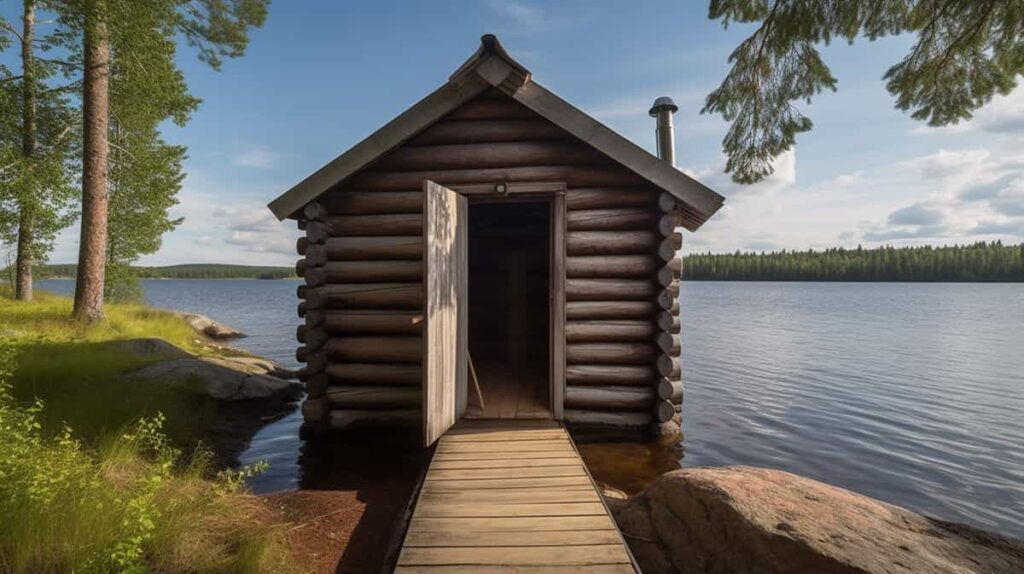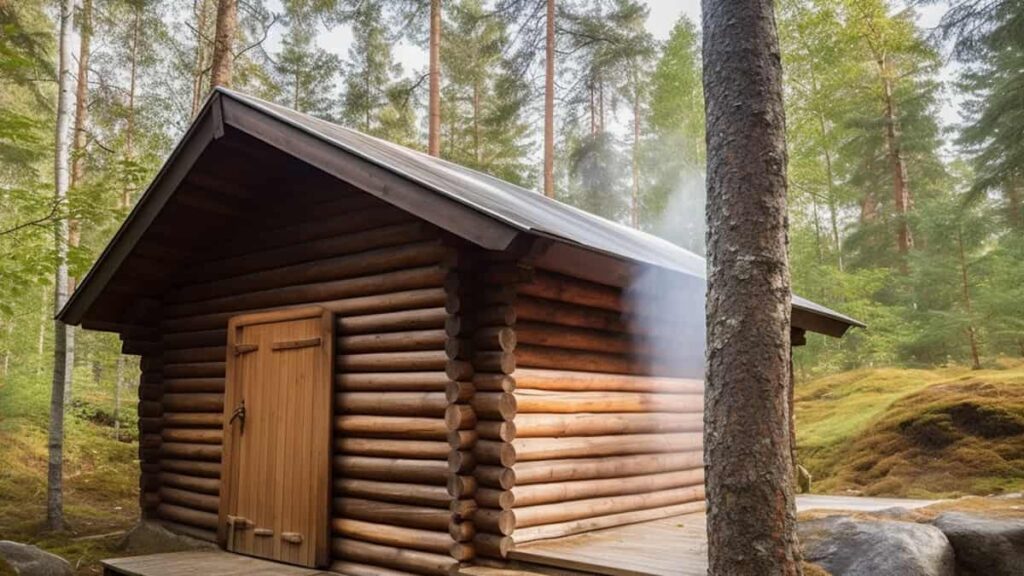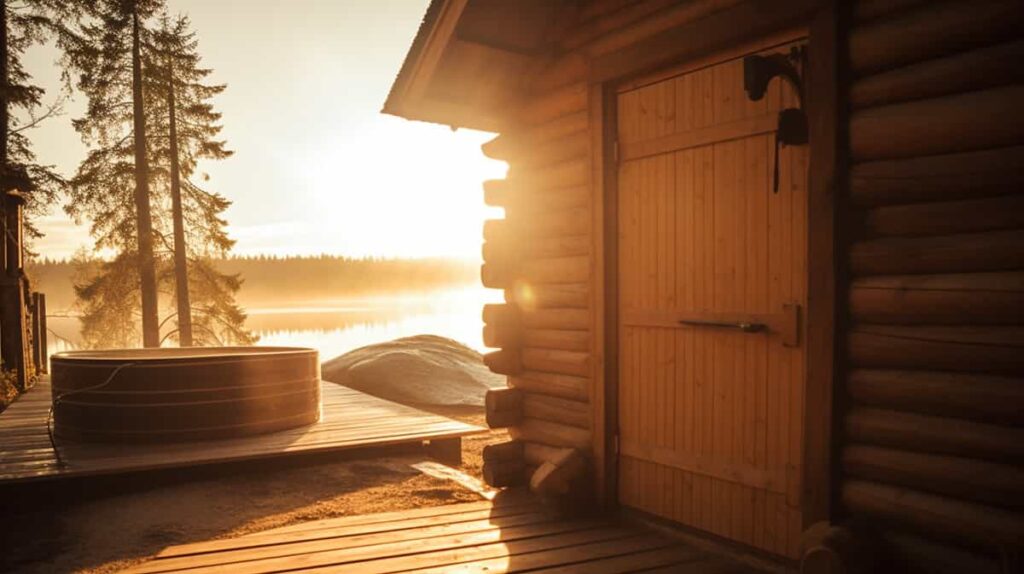The Finnish sauna holds a significant place in both Finnish and Estonian culture, featuring a rich history and a unique experience that differentiates it from other types of saunas worldwide. With the tradition inscribed on the UNESCO Intangible Cultural Heritage List, the Finnish sauna is a key aspect of Finland’s national identity and an integral component of local customs.
While there are various types of Finnish saunas, such as those heated by gas or electricity, the traditional wood-burning variety is deemed the most authentic and highly valued. The Finnish sauna stands apart from Turkish hammams and other sauna styles with its distinct etiquette, architecture, and levels of humidity or steam. Moreover, each Finnish sauna is believed to possess its own character and unique löyly, contributing to the overall enjoyment and rejuvenation of the experience.
The Origins of Finnish Sauna

It is challenging to trace the exact origins of the Finnish sauna, but its earliest versions are believed to date back to 7000 BC. The first recorded sauna bathing habits in Europe emerged around the same time, yet Finnish practices remained largely undocumented throughout history.
The earliest written account of a Finnish sauna dates back to 1112, mentioned in the writings of Nestor the Chronicler. By this time, the sauna tradition was already well-established in Finland, where people would sit in hot rooms and then douse themselves with cold water.
In Finnish culture, saunas were traditionally considered sacred spaces, reflective of a “church of nature.” This profound attachment to saunas has supported their continuous presence in the lives of Finns since ancient times.
Historically, Finnish saunas played a central role in various aspects of life. They were used for giving birth, providing a clean and warm environment for this critical event. Additionally, saunas were used to prepare the deceased for their final rites, symbolizing both the beginning and end of life for Finns.
Overall, the deep-rooted connection between Finns and their sauna culture continues to thrive in modern times, with saunas remaining a significant and cherished part of Finnish tradition.
Traditional Finnish Sauna Design

When it comes to creating the perfect Finnish sauna experience, the design elements are crucial. In this section, we will explore the traditional Finnish sauna design, focusing on features such as the wooden structure, stones and stove, and the heating process.
Wooden Structure
In a traditional Finnish sauna, the wooden structure plays an essential role in creating a calm and soothing environment. The choice of wood greatly impacts the sauna experience, often opting for materials such as cedar or spruce, which have a pleasant aroma and natural resistance to moisture and heat.
The walls and benches are typically constructed from this wood, providing a warm and inviting space for relaxation. Additionally, the use of wood in the structure helps to maintain a comfortable humidity level in the sauna.
Stones and Stove
The stones and stove contribute significantly to the authentic Finnish sauna experience. The stove, often wood-fired or electric, is responsible for heating the space, while the stones play a key role in creating löyly, or steam. Löyly is the result of pouring water over the hot stones, generating steam that envelopes the sauna and produces a unique, purifying sensation.
The stove’s design is simple yet effective, with the stones retained on top or within a compartment in the stove. The selection of stones is crucial as well, as they need to retain heat and endure the constant pouring of water without breaking.
Heating Process
Creating the ideal temperature and environment in a Finnish sauna is an art. The heating process typically begins with warming the space to a temperature between 176 and 212 degrees Fahrenheit, allowing the wooden structure to absorb heat and moisture. This process is vital as it helps to prevent the sauna from becoming uncomfortably hot or dry.
Once the space reaches the desired temperature, it is time to enjoy the sauna experience. This involves sitting or lying on benches installed at varying heights within the sauna, allowing users to find a comfortable temperature zone.
Create löyly steam by pouring small amounts of water over the heated stones as needed. This steam, combined with the heated wooden structure, creates a purifying and relaxing atmosphere that embraces body and mind alike.
Temperature and Humidity
In a Finnish sauna, the temperature and humidity levels play a crucial role in providing relaxation and various health benefits. The temperature in Finnish saunas usually ranges from 80 to 110 °C (176 to 230 °F), with most people preferring a temperature between 80 to 90 °C (176 to 194 °F).
The distinct feature of Finnish saunas is the löyly, a Finnish term for the steam produced by pouring water over hot stones. This creates a pleasant, moist heat in the sauna. The humidity levels in a Finnish sauna can range from 10% to 100%, but they are typically kept above the dew point so that steam condensation doesn’t occur like in a Turkish sauna.
Some Finnish saunas may also be heated by wood stoves, which can produce a slightly different heat and steam experience compared to electric stoves.
In contrast, Swedish saunas tend to have lower humidity levels (60 to 80 °C) and don’t typically use löyly. This difference in temperature and humidity, as well as the use of löyly, is what sets Finnish saunas apart from other types of saunas.
When using a Finnish sauna, it’s important to remember that competing to see who can withstand the most heat is both unhealthy and unnecessary – finding the optimal temperature for one’s comfort and well-being should be the priority.
The Finnish Sauna Experience

In this section, we will explore the unique Finnish sauna experience, including the different stages of enjoying a traditional Finnish sauna. Follow us as we walk you through the process, from preparation to the final cooling down.
Preparation
Before entering a Finnish sauna, it’s essential to take a shower to cleanse our bodies. Proper hygiene is crucial, as it helps to maintain a clean and enjoyable environment for everyone. Once we’re clean, we can put on a towel or a light, loose-fitting garment and leave our belongings in a designated area outside the sauna.
Löyly
Löyly is the term used for the steam that is created when water is poured onto hot stones in a Finnish sauna. This steam (or sauna “spirit”) is essential to the experience, as it helps to increase the humidity and elevate the heat. When we enter the sauna, we will find a box of water and a ladle. Gradually ladling water onto the stones will create löyly, enveloping us in a warm and relaxing steam.
Remember to take deep breaths and relax during this stage. The heat and steam help our muscles relax and open our pores, releasing toxins and providing a feeling of relief to our bodies. Make sure not to pour too much water at once, as it might make the heat unbearable.
Cooling Down
After enjoying the heat and steam in the sauna, it’s time to cool down. We can step out of the sauna, take a swim in a nearby lake, or enjoy a brisk shower with cold water. Cooling down is an essential part of the Finnish sauna experience, as it helps to balance our body temperature and improves circulation. In winter, some people may even choose to roll in the snow!
Repeating the Cycle
Now that we’ve cooled down, we can return to the sauna for another session of löyly, followed by another cooling down period. This process of alternating between heat and cold can be repeated a few times according to personal preference. The Finnish sauna experience aims to create a cycle of relaxation, invigoration, and rejuvenation for our minds, bodies, and souls.
In summary, the Finnish sauna experience is a unique combination of preparation, löyly, cooling down, and repeating the cycle. By embracing this traditional ritual, we can enhance our overall well-being and gain a deeper understanding of Finnish culture.
Health Benefits
As we explore Finnish saunas, let’s dive into their various health benefits, which span both physical and mental aspects. We’ll also look at scientific studies that support these advantages.
What physical and mental health benefits are exclusive to Finnish saunas
When it comes to Finnish saunas, they extend a broad range of health benefits due to their unique characteristics. The dry heat they generate can have profound effects on the body, with skin temperature soaring to about 104° F within minutes, leading to significant sweating.
Here are some key benefits:
- Detoxification: The deep sweating triggered by the high temperatures in Finnish saunas helps eliminate toxins and purify the body.
- Improved cardiovascular health: Regular sauna use and exercise have been found to reduce cardiovascular diseases.
- Stress reduction: Saunas can aid relaxation, alleviate stress, and positively impact mental well-being.
Scientific studies supporting Finnish Saunas
Several scientific studies have been conducted to understand and validate the health benefits. Finnish saunas have to offer. Some notable examples include:
- Cardiovascular benefits study: A study from PubMed highlights that sauna bathing can be linked to a reduced risk of heart and blood pressure diseases.
- Alzheimer’s risk reduction study: A 2016 study by Finnish researchers showed that regular sauna use was associated with a lower risk of developing Alzheimer’s disease.
It’s essential to approach these studies with a balanced perspective, as they do not claim to offer definite proof for each benefit. However, they do provide strong indications that Finnish saunas can contribute positively to overall health and well-being.
How Finnish Saunas Differ From Other Types of Saunas
In our exploration of Finnish saunas, we discovered several key characteristics that set them apart from other types of saunas. One significant difference is the use of heated rocks to produce steam. In Finnish saunas, rocks are heated to a high temperature and then sprinkled with water, creating a steamy environment with temperatures reaching up to 100°C (212°F). This process is different than the high-humidity saunas found in Turkish hammams, which involve more of a bath-and-scrub-like ritual.
Finnish saunas are typically heated with wood or electric stoves, which contributes to the overall atmosphere and experience. Traditional wood-burning Finnish saunas, also called dry saunas, have low to no humidity inside. These saunas are powered by a wood stove that heats stones, which in turn heat the wood-clad sauna compartment. Temperatures in these saunas can range from 140 to 200 degrees F.
Another notable aspect of Finnish saunas is their wooden interior, creating a cozy and inviting environment. The design of Finnish saunas often includes benches at various heights, allowing users to choose their preferred seat based on the intensity of heat they desire. Finnish sauna etiquette may also differ from the customs of other cultures, such as Estonian, Latvian, and Russian saunas.
Finally, as we learn more about Finnish saunas, it’s important to note that although they may share similarities with saunas from neighboring countries, their unique characteristics, ambiance, and traditions make them a distinct and valuable part of Finnish culture.
Modern Finnish Sauna Innovations
Over the years, Finnish sauna culture has experienced numerous innovations encouraged by technological advancements and modern user preferences while still preserving its traditional roots. In this section, we’ll explore some of these modern enhancements that have contributed to the continued popularity and adaptability of Finnish saunas.
One significant innovation is the development of the electric sauna stove. Traditional Finnish saunas relied on wood-burning stoves to generate heat, demanding manual effort and a continuous wood supply. The introduction of electric sauna stoves allows for precise temperature control, greater convenience, and environmentally friendly options, appealing to a broader audience.
Final Thoughts
In our exploration of Finnish saunas, it has become clear that they hold a special place in Finnish culture, with a rich history dating back thousands of years. Not only are they an integral part of daily life in Finland, but they also differ from other sauna types in various ways.
We learned that Finnish saunas typically utilize wood-burning stoves to create heat, offering a more traditional and authentic experience. There is also a focus on the concept of löyly, the unique character and steam produced in each sauna, which greatly contributes to the overall enjoyment of the experience for the sauna-goer. The distinct etiquette and practices within a Finnish sauna also set them apart from other sauna styles, such as Turkish hammams, which may involve more of a bath-and-scrub-like ritual.
Throughout our understanding of Finnish saunas, it’s evident that their significance goes beyond mere relaxation and leisure. They serve as a crucial aspect of socialization, well-being, and heritage in Finland. We hope that as we’ve delved into the uniqueness of Finnish saunas, we’ve also provided you with a deeper appreciation for this cherished tradition.
